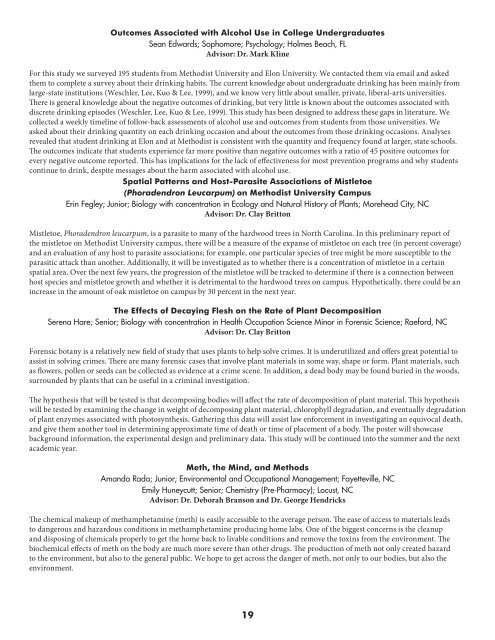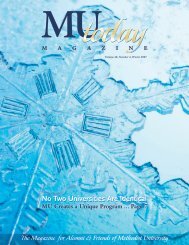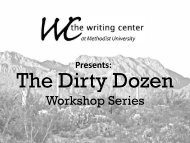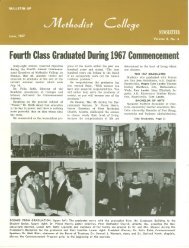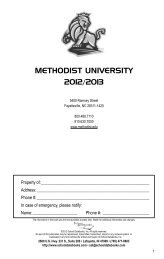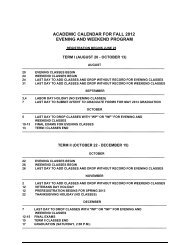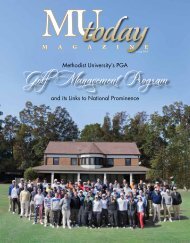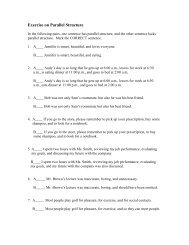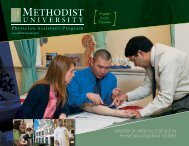Session Abstracts - Methodist University
Session Abstracts - Methodist University
Session Abstracts - Methodist University
You also want an ePaper? Increase the reach of your titles
YUMPU automatically turns print PDFs into web optimized ePapers that Google loves.
Outcomes Associated with Alcohol Use in College Undergraduates<br />
Sean Edwards; Sophomore; Psychology; Holmes Beach, FL<br />
Advisor: Dr. Mark Kline<br />
For this study we surveyed 195 students from <strong>Methodist</strong> <strong>University</strong> and Elon <strong>University</strong>. We contacted them via email and asked<br />
them to complete a survey about their drinking habits. The current knowledge about undergraduate drinking has been mainly from<br />
large-state institutions (Weschler, Lee, Kuo & Lee, 1999), and we know very little about smaller, private, liberal-arts universities.<br />
There is general knowledge about the negative outcomes of drinking, but very little is known about the outcomes associated with<br />
discrete drinking episodes (Weschler, Lee, Kuo & Lee, 1999). This study has been designed to address these gaps in literature. We<br />
collected a weekly timeline of follow-back assessments of alcohol use and outcomes from students from those universities. We<br />
asked about their drinking quantity on each drinking occasion and about the outcomes from those drinking occasions. Analyses<br />
revealed that student drinking at Elon and at <strong>Methodist</strong> is consistent with the quantity and frequency found at larger, state schools.<br />
The outcomes indicate that students experience far more positive than negative outcomes with a ratio of 45 positive outcomes for<br />
every negative outcome reported. This has implications for the lack of effectiveness for most prevention programs and why students<br />
continue to drink, despite messages about the harm associated with alcohol use.<br />
Spatial Patterns and Host-Parasite Associations of Mistletoe<br />
(Phoradendron Leucarpum) on <strong>Methodist</strong> <strong>University</strong> Campus<br />
Erin Fegley; Junior; Biology with concentration in Ecology and Natural History of Plants; Morehead City, NC<br />
Advisor: Dr. Clay Britton<br />
Mistletoe, Phoradendron leucarpum, is a parasite to many of the hardwood trees in North Carolina. In this preliminary report of<br />
the mistletoe on <strong>Methodist</strong> <strong>University</strong> campus, there will be a measure of the expanse of mistletoe on each tree (in percent coverage)<br />
and an evaluation of any host to parasite associations; for example, one particular species of tree might be more susceptible to the<br />
parasitic attack than another. Additionally, it will be investigated as to whether there is a concentration of mistletoe in a certain<br />
spatial area. Over the next few years, the progression of the mistletoe will be tracked to determine if there is a connection between<br />
host species and mistletoe growth and whether it is detrimental to the hardwood trees on campus. Hypothetically, there could be an<br />
increase in the amount of oak mistletoe on campus by 30 percent in the next year.<br />
The Effects of Decaying Flesh on the Rate of Plant Decomposition<br />
Serena Hare; Senior; Biology with concentration in Health Occupation Science Minor in Forensic Science; Raeford, NC<br />
Advisor: Dr. Clay Britton<br />
Forensic botany is a relatively new field of study that uses plants to help solve crimes. It is underutilized and offers great potential to<br />
assist in solving crimes. There are many forensic cases that involve plant materials in some way, shape or form. Plant materials, such<br />
as flowers, pollen or seeds can be collected as evidence at a crime scene. In addition, a dead body may be found buried in the woods,<br />
surrounded by plants that can be useful in a criminal investigation.<br />
The hypothesis that will be tested is that decomposing bodies will affect the rate of decomposition of plant material. This hypothesis<br />
will be tested by examining the change in weight of decomposing plant material, chlorophyll degradation, and eventually degradation<br />
of plant enzymes associated with photosynthesis. Gathering this data will assist law enforcement in investigating an equivocal death,<br />
and give them another tool in determining approximate time of death or time of placement of a body. The poster will showcase<br />
background information, the experimental design and preliminary data. This study will be continued into the summer and the next<br />
academic year.<br />
Meth, the Mind, and Methods<br />
Amanda Rada; Junior; Environmental and Occupational Management; Fayetteville, NC<br />
Emily Huneycutt; Senior; Chemistry (Pre-Pharmacy); Locust, NC<br />
Advisor: Dr. Deborah Branson and Dr. George Hendricks<br />
The chemical makeup of methamphetamine (meth) is easily accessible to the average person. The ease of access to materials leads<br />
to dangerous and hazardous conditions in methamphetamine producing home labs. One of the biggest concerns is the cleanup<br />
and disposing of chemicals properly to get the home back to livable conditions and remove the toxins from the environment. The<br />
biochemical effects of meth on the body are much more severe than other drugs. The production of meth not only created hazard<br />
to the environment, but also to the general public. We hope to get across the danger of meth, not only to our bodies, but also the<br />
environment.<br />
19


